20 best ceiling skirting boards: 2023 rating, review, photos
Ceiling plinths are additional finishing elements. Serve for decoration and add completeness to the design. They mask flaws and decorate ceilings of complex structures and columns.The best models come in wide and narrow, different colors, textures and shapes.
The content of the article:
How to choose the right ceiling plinth
Another name for ceiling plinth is fillet. This is both a protective and decorative element that hides the gap between the ceiling and the wall. Moreover, if it is attached to the wall, it is called a plinth; if it is attached to the ceiling or floor, it is called a fillet. Although this name is rarely used. More often the part is made of foamed polyvinyl chloride or gypsum.
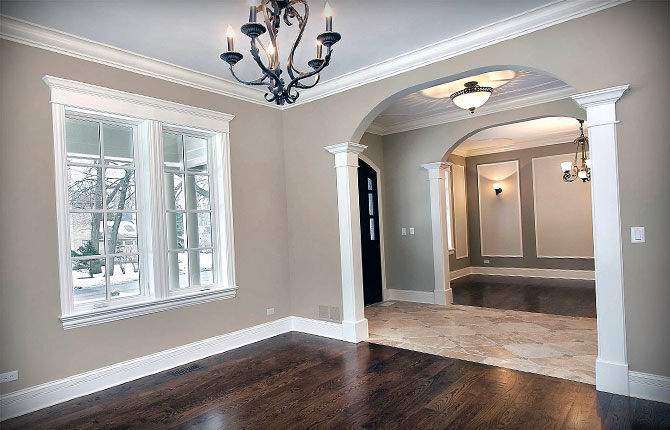
In a large assortment of models, it is difficult to understand and determine which ceiling plinth is better. First of all, you should decide what role the cornice should play in your interior:
- Close the problem area after repair.
- Add height or width to a room.
- Hide communications.
- Arrange an additional lighting source.
- Use as decoration.
- Accentuate the chosen style of the room.
The ceiling plinth is chosen based on the tasks set, the dimensions of the room, taking into account the shape, color, and material. For example, if you need to purchase planks for all rooms in the apartment at once, it is better to take fillets of the same texture and shape, matching the color to each room, but differing in width. Reputable companies, as a rule, have several size options for the same model.
Material
Modern production technologies make it possible to produce ceiling plinths using a variety of raw materials. These are mainly polymers (foam plastic, polystyrene, polyvinyl chloride, polyurethane), as well as wood and gypsum. Each material has its own characteristics and features, which should be taken into account during operation.
Polystyrene foam, foamed plastic, is the most common material. It has a low weight and is easy to process. It can be cut with a stationery knife. Products made from it are inexpensive and available in hardware stores. Allows you to quickly complete repairs. The disadvantage of the material is that it is highly flammable. It is susceptible to acetone and paint, but quickly decomposes. In case of careless work, dents and scratches remain.
Expanded polystyrene is a type of foam plastic. Its production is carried out by foaming or extrusion. The foam material has the same characteristics as polystyrene foam. The planks are fragile and cannot be bent. Extruded polystyrene is more durable. It has greater impact resistance and better fire resistance. Low moisture absorption allows it to be used in the kitchen and bathroom.
Thanks to innovative technologies, manufacturers offer analogues of extruded polystyrene - this is duropolymer or injection polystyrene foam. The material has a smooth structure, more elastic, and is easy to clean.Accordingly, its price is higher.
Polyvinyl chloride is a durable, versatile material. Flexibility allows installation on walls with large curvature. These are ceiling plinths with a wide variety of reliefs and patterns. Does not release toxic substances into the air. Disadvantage - restrictions on temperature conditions (cracks, crumbles). Cannot be painted.
Polyurethane is used to make fillets with a smooth texture and a pattern. The material is durable, flexible, easy to cut, and mounted on uneven walls. It is not afraid of temperature fluctuations and does not adsorb water, which allows it to be installed in unheated and damp rooms. Such ceiling plinths are somewhat more expensive, but more affordable than plaster and wood.
The safest composition of the polymer material is albumin-casein (FBA) or urea glue (UK). Bakelite varnish (FB) is less safe. It is not advisable to use phenol-formaldehyde composition (FSF) inside a residential area.
Gypsum ceiling plinth has its advantages. A good choice when there is a task to emphasize a certain style (classicism, rococo, baroque) or to create an unusual design. This is an environmentally friendly, reliable material, resistant to fire. Patterned stucco molding is rich in the choice of forms, exclusive and aesthetic.
Disadvantages include fragility and, sometimes, significant weight, difficulty in fastening. The price is high, but, if desired, you can make a plaster frieze yourself.
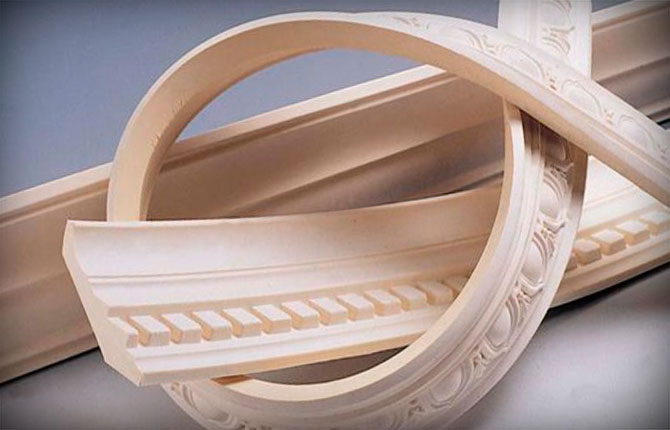
Wooden ceiling plinth is considered one of the elite finishing methods. This is a full-fledged shaped profile, a classic of the time, the warmth and beauty of natural wood for creating an interior. Cornices are made of solid wood or veneered. They require treatment with moisture-resistant and antiseptic solutions.
There is some difficulty in installation. It is necessary to level the walls and adjust the internal and external corners. Wooden models are not installed in bathrooms; excess moisture causes the material to deteriorate.
Texture and shape
Ceiling plinths vary in type of surface. The smooth or laminated type is characterized by a flat surface without recesses, ornaments, or patterns. Unlike the extruded type, which has longitudinal grooves. It is made by pressing liquid polystyrene mass through special holes, forming a dense structure with indentations. This fillet can be painted and, if necessary, wiped with a damp cloth.

Skirting boards are made in molds by baking polystyrene foam granules. When choosing, you should consider the finish of the ceiling and walls. If the room has an active, bright design, then the ceiling plinth should be smooth, without a pattern. And vice versa, a textured cornice will suit the restrained decoration of the walls and ceiling and will enliven the interior.
The most versatile are fillets of simple shapes. When installing ceiling plinths with complex terrain, precise adjustment of the elements at the joints is necessary.
According to the manufacturing method, gypsum cornices can be cast, smooth-drawn, or molded. Shape: curvilinear and radial. They are made from gypsum mixture using templates. Models of a certain size and shape are most often used for joining bars to fireplaces or stoves. They also design and decorate public buildings and shopping centers according to fire safety requirements. The ceiling plinth should not be interrupted above the doorway.
Color
The general rule is that the shade of the ceiling plinth should match the color of the ceiling or walls.But there are some subtleties. For low rooms they are painted to match the color of the walls, which visually raises the ceiling. If the space is small, the ceiling and cornice should be the same color. In this case, a small room will seem wider. If the walls and ceiling are the same color, the ceiling frieze should be different. However, a bold contrasting solution may not always be successful.
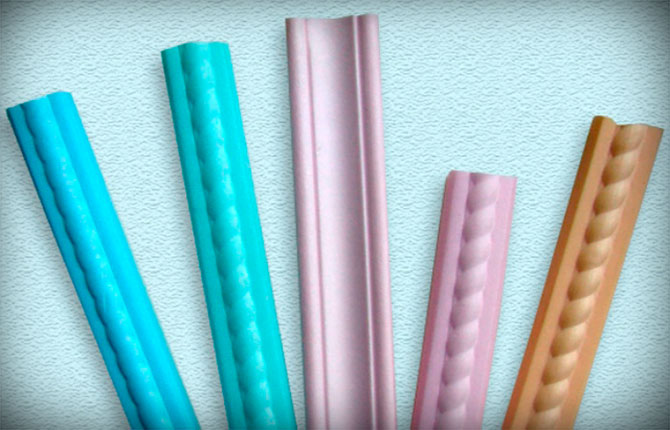
A win-win alternative is a white fillet, since the ceilings are mostly light shades. When choosing a color, you can focus on the following points:
- White color moves away, so light-colored ceiling plinths will visually appear further away, and the room itself will appear larger. This is especially true for small apartments, like Khrushchev.
- Blue color is also capable of distancing. But cool blue shades are not entirely suitable for a living room. Therefore, it is better to install blue baguette strips in the bathroom or toilet.
- Dark baseboards of the same color as the wallpaper visually bring the corners closer, making the room smaller. Therefore, they are suitable for large rooms.
- Contrasting with wallpaper, dark colors look great, although they “eat up” the space a little. It is important that such fillets match the color of other parts or furniture.
- Red excites and excites emotions. It is recommended to use it to a minimum, in detail.
- Orange energizes and increases appetite. It is good to add to the interior of the kitchen.
A variety of colors can make any fantasy come true. The main thing is that the color of the plinth emphasizes the interior decoration, shades or merges with it. In any room it is important to follow the rule of 3 colors. After all, a person feels normal where there are two, maximum three colors.The main one accounts for 60%, the additional 30%, the remaining 10% can be bright, contrasting details.
To choose a plinth for the ceiling, you need to consider some points. Narrow slats are more suitable for bathrooms and kitchens. Medium ones are installed in small living rooms, offices, bedrooms. Wide, combined with a diagonal of more than 150 mm, will decorate spacious high rooms and halls.
It is recommended for a room with a low ceiling (no more than 2.5 m in height) to take a ceiling plinth up to 8 cm wide. For high rooms (above 3 meters) - over 8 cm. Models with a width of 10-12 cm are most in demand. How As a rule, they are suitable for any design. There are models from 30 cm, they are rarely used, if style or necessity requires it. A wide frieze will help align the corners, create the appearance of a rounded room, and cover the joints of the suspended ceiling.
Thus, the best ceiling plinths in the line of stucco decor are also suitable for suspended ceilings. Their difference from a cornice is that they are attached to only one support point (the wall). In this case, the tension fabric itself is not affected. For a stretch ceiling, choose the lightest, widest cornice that fits well to the wall. He might be from polystyrene foam, polyurethane, expanded polystyrene.
The ceiling plinth cannot be used for the floor, as it is only glued to the wall. For uneven walls, choose a PVC baguette with soft edges, then they will fit tightly. When designing complex structures and columns, installation is carried out after leveling the walls and ceiling, before wallpapering or painting. The material of the backlit model must be fire-resistant, with small sides.
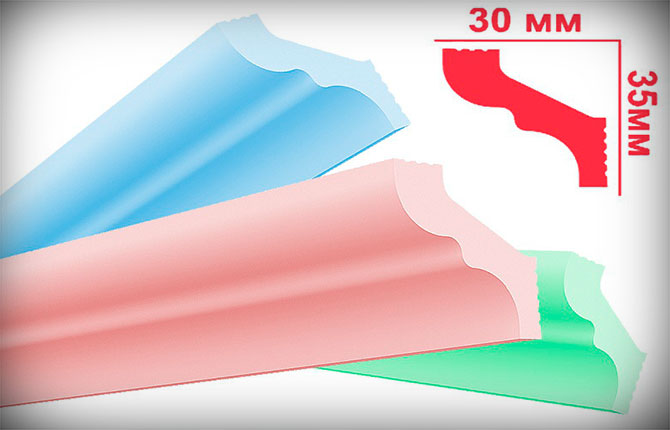
Self-installation is not difficult.To do this you will need glue, a stationery knife, a ruler, a pencil, and a level. As well as a spatula, brush or roller for applying the adhesive, and napkins to remove any remaining adhesive.
It is important to know what glue can be used for different types of ceiling skirting boards:
- polystyrene ones are attached using polymer and polyvinyl acetate glue;
- foam plastic - on acrylic putty;
- polyurethane glued to liquid nails;
- wooden - using high-adhesive glue and self-tapping screws;
- for gypsum, a polyvinyl acetate composition, a mixture of alabaster and PVA is used.
The ceiling plinth can be glued to the wallpaper on the wall with “Moment Installation” or “Tytan”. Polyurethane foam is used if the fillet has no finishing. Another good option is acrylic putty. Heavy polyurethane ceiling plinths are attached to a special adhesive for stucco molding and decorative finishing.
There is a device for cutting ceiling plinths - a miter box. This is a small rectangular box without end sides, with slots at a certain angle (22.5; 45; 90 degrees). The plinth is installed inside, the cut is made at the desired angle.
Currently, shadow joints and jute rope are increasingly used as an alternative to plinths when installing plasterboard structures. As well as door casing, decorative panels, window glazing bead. Ceramic tile border and LED strip. The joint between the ceiling and the wall is closed with a plug. This is a PVC and profile insert.
Rating of the best duropolymer ceiling skirting boards
The demand for such models is increasing every year, due to excellent characteristics and relatively low prices. Duropolymer fillets have advantages over foam plastic:
- the material does not absorb odors;
- moisture-resistant structure;
- does not dry out, does not crack;
- shockproof design;
- not subject to shrinkage;
- the surface can be painted.
Before deciding which ceiling plinth to choose, check out the best models.
WT22 NMC
Smooth ceiling cornice from a line of functional profiles, ceiling moldings. Suitable for indoor installation. Brand WALLSTYL® (Belgium), Manufacturer NMC "NMC".
Made from high-strength material of excellent quality, durable and resistant to damage. Covered with a white primer for painting. Easy to install. For installation, you can use Adefix P5 NMC mounting adhesive or docking Adefix Plus NMC.
Parameters: length 2000 mm, height 100 mm, width 225 mm.
ORAC AXXENT CX107
Ceiling plinth with an ornament from the ORAC DECOR brand for stucco production. Made from high strength polymer. It has an increased strength coefficient and a wear-resistant coating. The service life is unlimited. Stated dimensions: 2000 x 120 x 120 mm.
Europlast 6.50.229
Ceiling plinth from the manufacturer "Europlast". Made of thermoplastic polyurethane, not flexible. Surface with anti-vandal properties. Cornice for lighting, white. If it is necessary to hide the lighting, the inner surface is treated with a reflective element. Use a power tool to cut down corners with caution. Possible edge melting.
Dimensions: 2000 x 120 x 48 mm.
DECOMASTER D501 DM
High-quality duropolymer molding from DECOMASTER. Grace and luxury combined with practicality. It hides unevenness and performs a decorative task - to visually unite or separate the strip of ceiling and walls.The dimensions of the ceiling plinth are 2000 x 73 x 40.
Grand decor KH 906
Duropolymer cornice for lighting. Quality – “Premium”, 100% environmentally friendly coating (white primer for painting). Can be painted with any type of paint. Solid, moisture-resistant, high-strength ceiling plinth. Easily mounted using FDP500 DecoFix Pro mounting adhesive.
Size 2000 x 52 x 24. Joining adhesive FX210 ORAC DecoFix Extra.
Grand decor KH 902
Duropolymer solid cornice is part of the new product line of the Grand decor brand. Type – for illumination. The product is highly durable, moisture-resistant, impact-resistant. Has an unlimited service life. The top layer is a white primer. Can be painted with any interior paint. Ideal value for money. Dimensions 2000 x 40 x 22 mm.
WallStyle WO1
Wall molding with ornament from the WallStyl collection, duropolymer material. A combination of classic and modern aesthetics. Can be installed both horizontally and vertically. Pairs well with other NMC products. The material is durable with a white primer, can be painted or added elements.
Dimensions: 2000 x 38 x 18 mm.
Rating of the best polystyrene ceiling skirting boards
Skirting boards made of polystyrene are also called foam plastic. Their main difference is the variety of textures, shapes and sizes. And the low price gives an advantage over expensive options. Therefore, polystyrene models are widely used for interior decoration.
Positive aspects of polystyrene products.
- The spectacular texture and sophisticated look will add originality to the interior of your room.
- No special equipment or tools are needed for installation. You can cut with a sharp knife or a metal file.One person can handle the job independently.
- The plinth is lightweight and does not create additional load. Excellent for finishing suspended ceilings.
- Not afraid of mold, resistant to “colonization” of microorganisms.
- It is not affected by moisture and does not change its size due to temperature changes.
- The edges of the fillets are soft, which allows you to hide all the irregularities.
Polystyrene skirting boards have minor disadvantages. Their surface is somewhat rough, with a gray tint. And when exposed to sunlight it turns yellowish. Due to their increased fragility, they are easy to break during transportation and installation. These flaws are completely removable. They can be painted to change the color. Given the relatively low prices, it is possible to purchase several spare strips.
Dellos Baget 3622
Smooth ceiling plinth with a straight edge. Material – polystyrene. Does not fade, is resistant to moisture and mold. Can be painted, large selection of sizes, shapes and colors. Easy to cut and install on a degreased surface using acrylic glue. Implemented in solid strips. Dimensions – 2000 x 36 x 22 mm.
Ceiling cornice A137
Polystyrene plinth with ornament. Used indoors to cover the gap between the ceiling and the wall. At the same time it is a decorative element. Made from polystyrene using a special technology - increasing strength and reducing weight. Dimensions – length 1300 mm, height 35, width 30.
Orac Decor CB520
Interior decor for ceilings and walls (Belgium). The Orac Decor company develops and manufactures products for interior design using its own technologies. Stucco material is polystyrene. The surface is primed for painting. Skirting boards are flexible and easy to install. Not susceptible to fumes.Dimensions: 2000 x 35 x 35 mm.
Baguette GP-26
Decorative ceiling plinth made of high-density polystyrene. An elegant design will bring solemnity, luxury and at the same time elegance. Thanks to its smooth surface and clear pattern, the plank imitates gypsum stucco. Unlike gypsum, it is lightweight, can be successfully attached with Glanzepol glue, and is suitable for stretch and suspended ceilings, hidden wiring and plastic panels. Baguette size 118 x 54 mm.
Baguette Glanzepol GP-75
Decorative plinth from a premium series of ceiling models. German quality injection material. Eco-friendly, non-toxic, quality control at all stages of production. Almost indistinguishable from gypsum stucco. The high density of coloring allows you to imitate natural wood or stone. You can choose a model according to the ceiling height and style of the room. Dimensions 141 x 141 mm.
Baguette GP-15
Exclusive ceiling plinth with a diagonal of 110 mm, Glanzepol brand. Matte surface for painting. Suitable for all styles, as well as high and low spaces. It will emphasize the geometry of space and visually expand it. High quality allows for perfect pattern joining. Plank size 78 x 78 mm.
Rating of polyurethane ceiling skirting boards
This material is the most durable and reliable. Polyurethane type of finishing is the most popular. Fillets can be both rigid and flexible, with a smooth profile or with an ornament. The latter's flexible polyurethane curtain rods contain rubber. They are an exact copy of hard models. It is important to pay attention to the possible minimum bend size. This is the radius at which the baseboard does not deform.
The products are not affected by temperatures and high humidity, and do not absorb odors. A variety of shapes and patterns allows you to choose a model to suit any style. They can be painted with acrylic paint, choosing a color that matches the ceiling or walls. The surface is easy to clean.
You can install it yourself. The material does not break, does not crumble, and can be cut with a knife. For fastening, putty, liquid nails or special glue are used. Most often, putty is used. It closes the gaps at the joints well.
Negative side - not recommended for use on suspended ceilings. In order to secure the polyurethane well, the adhesive is applied to both sides. and this is unacceptable in the case of fabric or film covering. The other downside is the high price.
WALLSTYL WT3
Original ceiling cornice with a niche for ceiling lighting. Country of origin: Belgium. European quality - durable, lightweight and flexible material, resistant to impacts. Withstands temperature fluctuations and does not absorb moisture. Can be used both in the bathroom and on the veranda. Installation is carried out with original NMC glue. Covered with interior paint. Parameters: 2000 x 130 x 80 mm.
Gaudi Decor P 205
The polyurethane cornice is made of environmentally friendly high-density polymer. Does not release toxins. Used indoors. Resistant to damage. Does not absorb moisture and odors, is resistant to mold, does not crack. Can be painted to match the walls. The cornice is rigid, but has flexible analogues of different sizes and shapes. Size 2440 x 57 x 53 mm.
CLASSIC 3008HQ
Polyurethane plinth with ornament from the company BOVELACCI (Italy). Designed for installation inside a living space.
Products in the Classic line are made of impact-resistant material – polyurethane. Combines traditional classic elements with elegance. Especially suitable for country, retro, Provence style. Dimensions of one strip are 2000 x 68 x 40 mm.
Orac Decor C211
The material is environmentally friendly, strong and durable. It has characteristics such as moisture resistance and heat resistance. Does not cause allergic reactions. Can be installed anywhere in an apartment or house. The rigid plinth with ornament has dimensions of 2000 x 115 x 110 mm.
Classic Home HM-42030-Q
Corner flexible polyurethane plinth with profile, made in China. Primed, white, for indoor use. Dimensions: 2400 x 30 x 30 mm.
Europlast 1.50.289 Flex
Material – flexible polyurethane for decoration. Used in finishing ceilings and walls. The surface is white, primed, ready for painting. There is a cable channel. Main parameters – 2000 x 55 x 37 mm.
Europlast 1.50.289
Rigid polyurethane ceiling plinth is a regular analogue and has the same characteristics as the previous one.
A very traditional solution - installing a baguette at the junction of walls and ceilings - does not lose its relevance. In order for the cornice to complement the interior and fit harmoniously into the design of the room, before choosing, you should carefully study the features of the fillets and find out their strengths and weaknesses. In any case, the buyer himself decides which type of ceiling plinth to choose.
What criteria did you use to select the ceiling cornice? Leave your comment, share the article on social networks, add it to bookmarks.
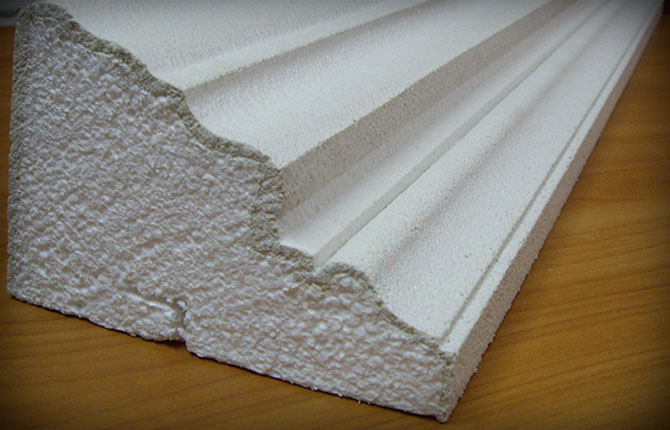
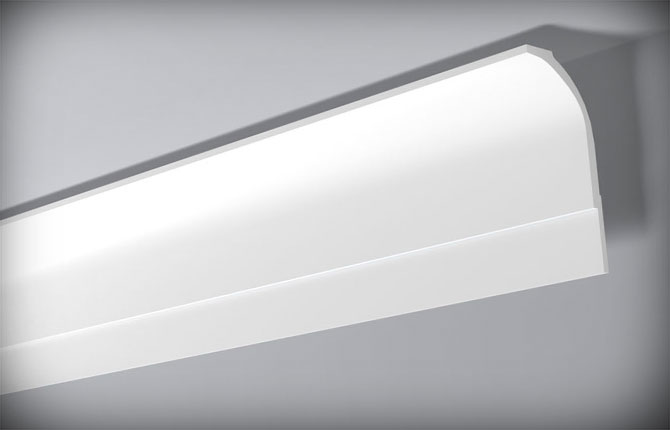
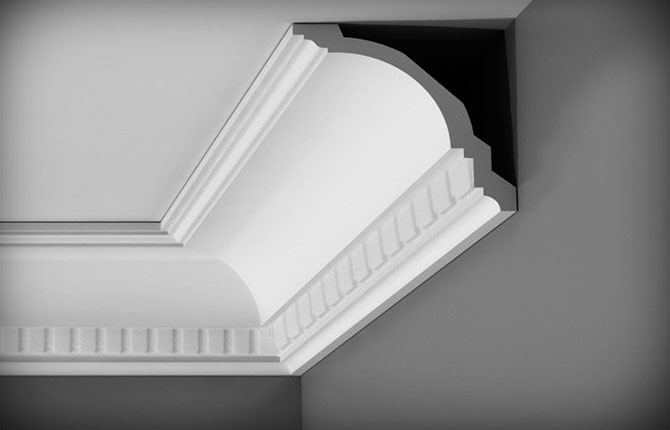
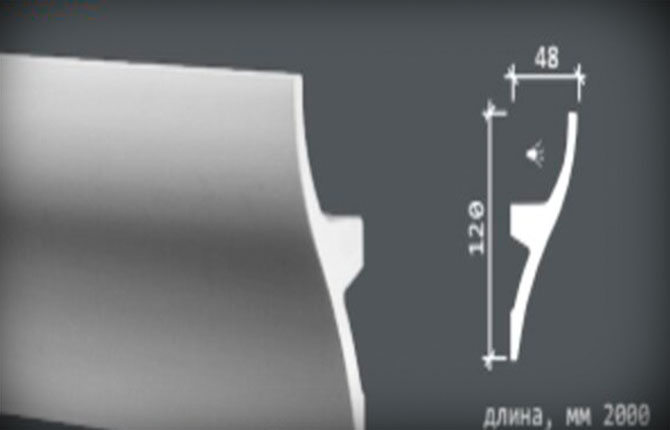
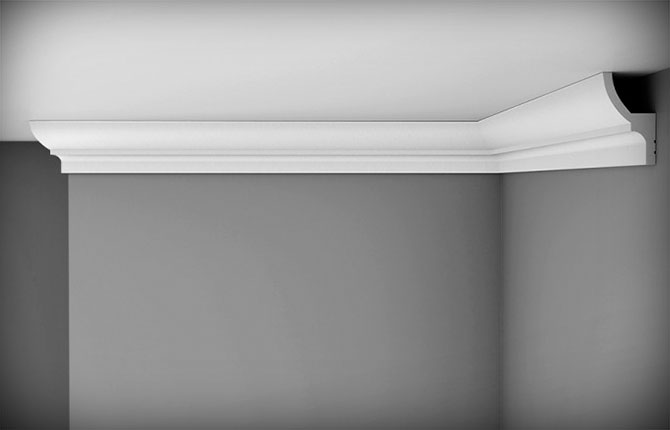
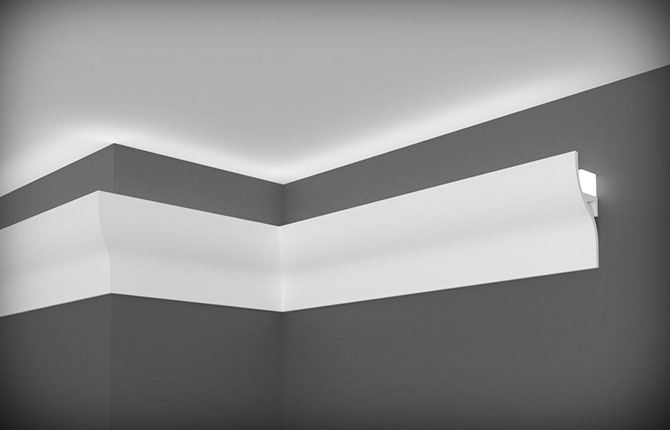
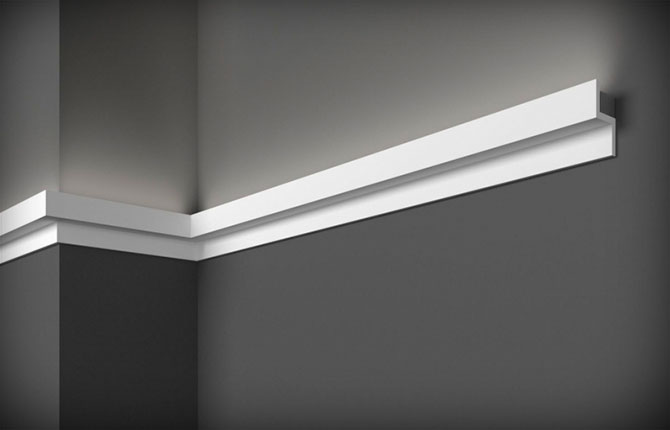
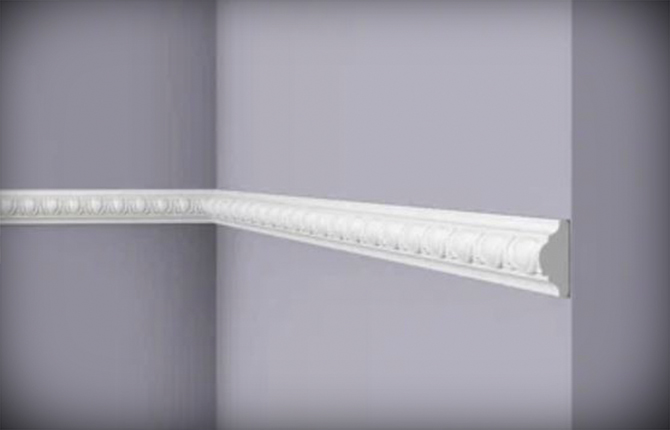
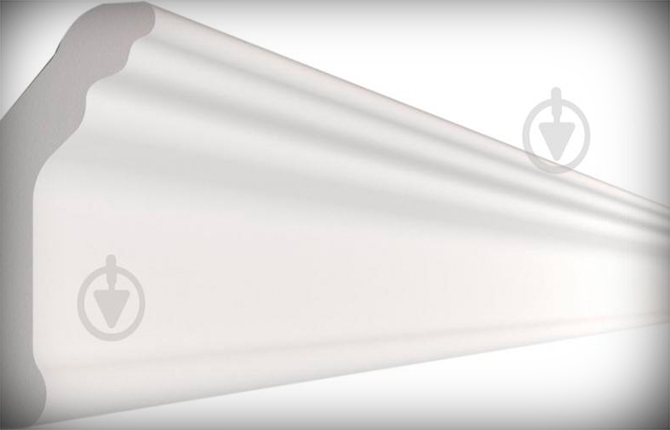
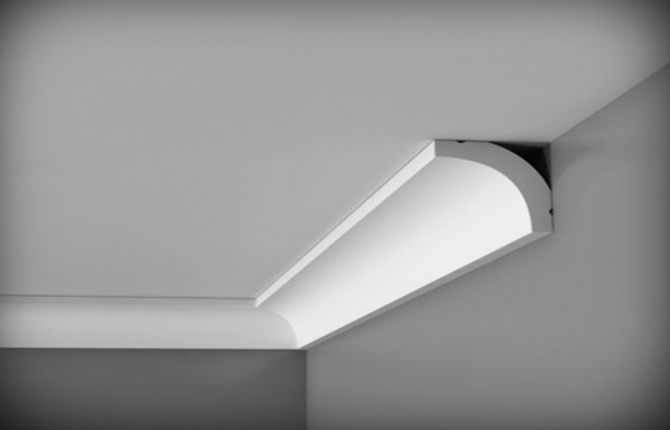

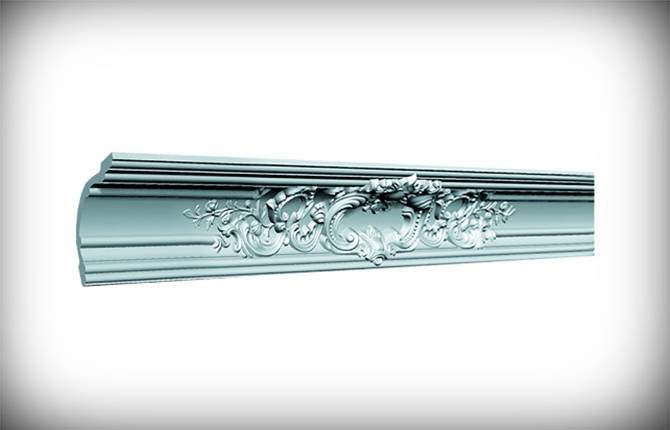
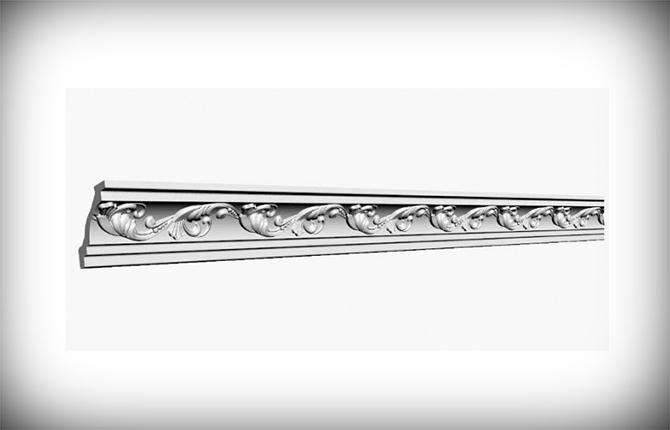

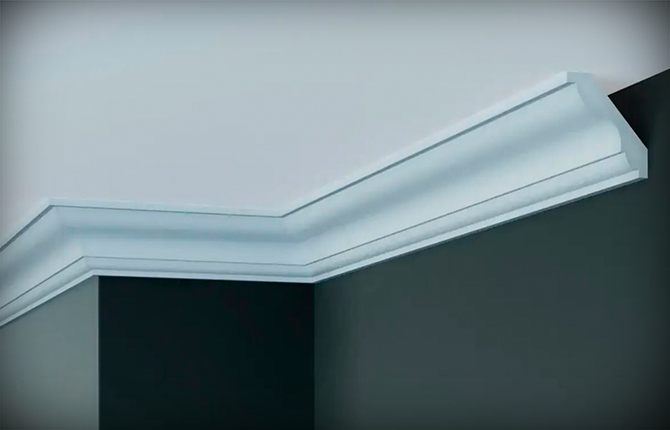
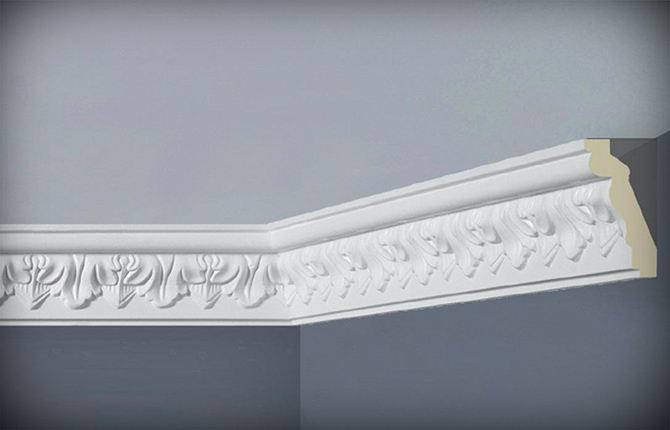
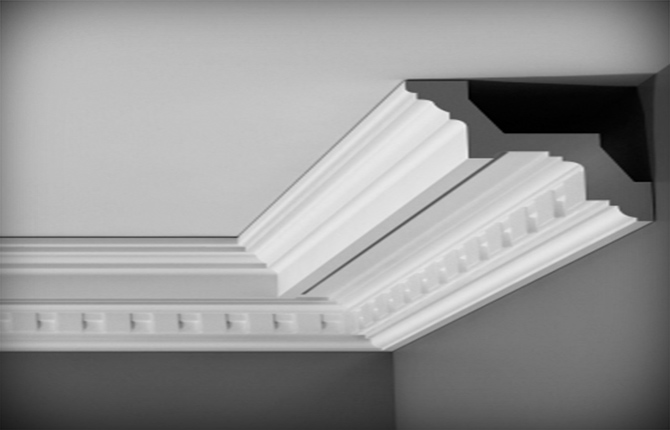
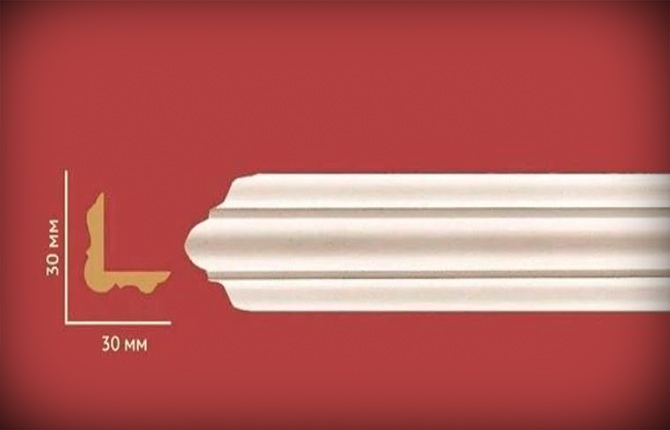
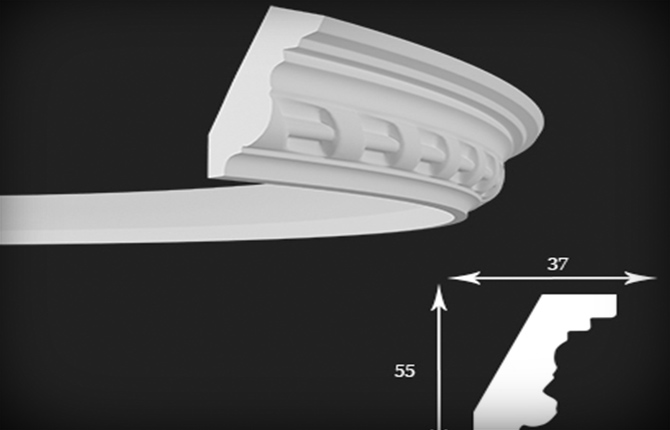
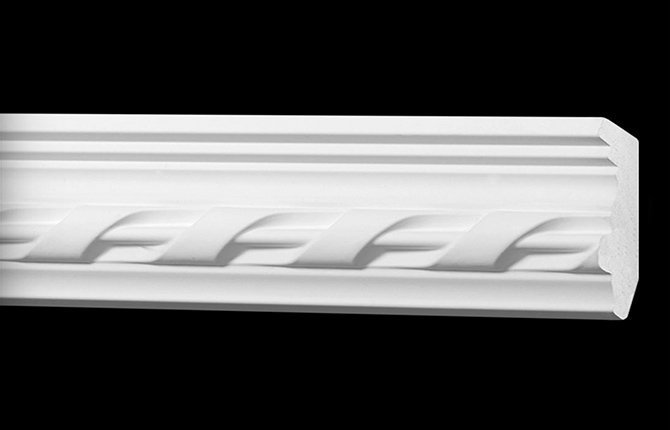

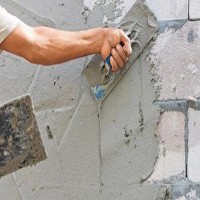
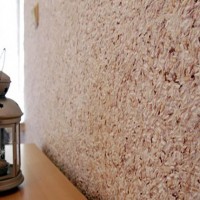

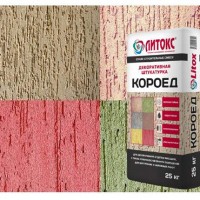




When we moved into the apartment, we made renovations and decided to use ceiling moldings. They are different. We bought it from polystyrene foam, an average width of two meters long, with a classic pattern. This is a budget option. They can be used between the ceiling and the wall, as well as decoratively decorate the walls by making huge frames. We put it in all the rooms, even in the bathroom. Repairs take a lot of money, and it’s nice to save a little at the end of the renovation by spending pennies for such a beautiful view under the ceiling. They are durable despite being made of fragile material.
Not long ago I was doing renovations in my apartment. I decided to install suspended ceilings in the room; naturally, there were small gaps between the wall and the ceiling. These are the ones I covered with the ceiling plinth. I chose one with a pattern, white. They are made of polystyrene, the material is very light and fragile. Easy to cut with a utility knife. I glued it with colorless instant glue to the wallpaper. The whole job took me about an hour. The result was excellent, neat and beautiful.
My renovation is ongoing. The torment began with the choice of skirting boards, but it ended quickly, and there was something to agonize over. A friend of ours installed foam baseboards. I've heard a lot from people that if you make a mistake with the glue, it will eat right through the foam profile. After a few years they dry out.If you make a mistake with the primer, it will come off the baseboard and the paint will not adhere. I was horrified and bought polyurethane ones. When we glued all the baseboards, the seams between the sticks were noticeable. It's not scary. We pour the sealant in a thin line into the seam, run a clean finger along the seam, as if removing excess. After that, let it dry and paint. We seal the cracks with sealant if the wall is not level. We do the installation using glue.